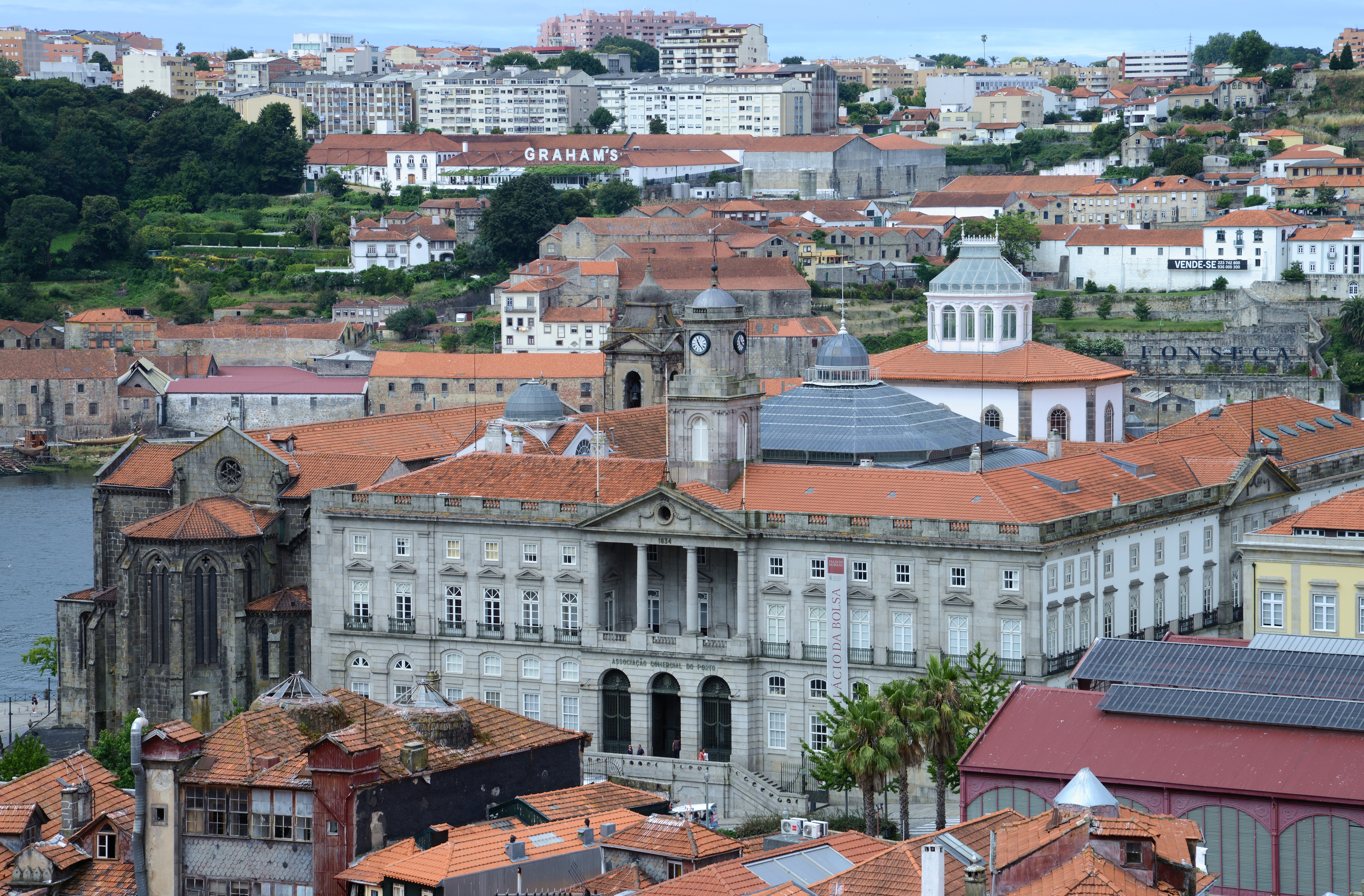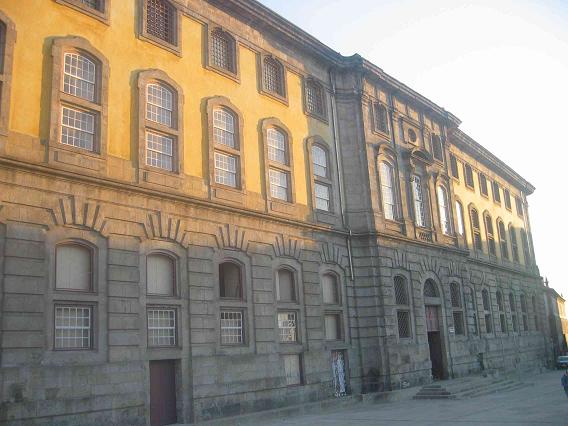|
Palácio Da Bolsa
The Stock Exchange Palace () is a historical building in Porto, Portugal. The palace was built in the 19th century by the city's Commercial Association () in Neoclassical style. It is located in the Infante D. Henrique Square in the historical centre of Porto, designated World Heritage Site by UNESCO. History The Palácio da Bolsa is located beside the St Francis Church of Porto, which was once part of the St Francis Convent, founded in the 13th century. In 1832, during the Liberal Wars, a fire destroyed the cloisters of the convent, sparing the church. In 1841, Queen Mary II donated the convent ruins to the merchants of the city, who decided to use the spot to build the seat of the Commercial Association. Building work began in 1842 following the plans of Porto architect Joaquim da Costa Lima Júnior, who designed a Neoclassical palace of Palladian influence, inspired by previous structures built in the city. Most of the palace was finished by 1850, but the decoration of the in ... [...More Info...] [...Related Items...] OR: [Wikipedia] [Google] [Baidu] |
Porto July 2014-31a
Porto or Oporto () is the second-largest city in Portugal, the capital of the Porto District, and one of the Iberian Peninsula's major urban areas. Porto city proper, which is the entire municipality of Porto, is small compared to its metropolitan area, with an estimated population of just 231,800 people in a municipality with only 41.42 km2. Porto's metropolitan area has around 1.7 million people (2021) in an area of ,Demographia: World Urban Areas March 2010 making it the second-largest urban area in Portugal. It is recognized as a global city with a Gamma + rating from the |
Carlos Amarante
Carlos Luís Ferreira da Cruz Amarante (Braga, 1748 - Oporto, 1815) was an important Portuguese engineer and architect. Amarante's father was musician in the court of the Bishop of Braga. He began pursuing an ecclesiastical career, but left the seminary when he was 23 years old to marry Luísa Clara Xavier. After that he pursued a career in engineering and architecture. Artistically, Amarante led the transition between the late Baroque-Rococo architecture of northern Portugal to modern Neoclassical architecture. He was particularly influenced by the many Neoclassical buildings of English inspiration that were built in Oporto during the 18th century. The church of the sanctuary of Bom Jesus do Monte, built after 1784 to a design by Amarante, is considered one of the first Portuguese churches in Neoclassical style. Amarante is buried in the Trindade Church in Oporto. Works *Bom Jesus do Monte - Braga *Populo Church - Braga *Hospital Church - Braga *São Gonçalo Bridge over th ... [...More Info...] [...Related Items...] OR: [Wikipedia] [Google] [Baidu] |
Museums In Porto
Porto, a popular tourist destination in Portugal, is the country's second largest city. It is located along the Douro, Douro river estuary in Northern Portugal. Porto is one of the oldest European centers, and its historical core was classified a World Heritage Site by UNESCO in 1996. Landmarks Religious sites Museums Parks and gardens Others Nearby places See also * Porto * Tourism in Portugal References External links Official website of Porto City Hall {{Wikivoyage, Porto Lists of tourist attractions by city, Porto Tourist attractions in Porto Lists of tourist attractions in Portugal, Porto ... [...More Info...] [...Related Items...] OR: [Wikipedia] [Google] [Baidu] |
Tourist Attractions In Porto ...
Porto, a popular tourist destination in Portugal, is the country's second largest city. It is located along the Douro river estuary in Northern Portugal. Porto is one of the oldest European centers, and its historical core was classified a World Heritage Site by UNESCO in 1996. Landmarks Religious sites Museums Parks and gardens Others Nearby places See also * Porto * Tourism in Portugal References External links Official website of Porto City Hall {{Wikivoyage, Porto Porto Tourist attractions in Porto Porto Porto or Oporto () is the second-largest city in Portugal, the capital of the Porto District, and one of the Iberian Peninsula's major urban areas. Porto city proper, which is the entire municipality of Porto, is small compared to its metropol ... [...More Info...] [...Related Items...] OR: [Wikipedia] [Google] [Baidu] |
Palaces In Porto
A palace is a grand residence, especially a royal residence, or the home of a head of state or some other high-ranking dignitary, such as a bishop or archbishop. The word is derived from the Latin name palātium, for Palatine Hill in Rome which housed the Imperial residences. Most European languages have a version of the term (''palais'', ''palazzo'', ''palacio'', etc.), and many use it for a wider range of buildings than English. In many parts of Europe, the equivalent term is also applied to large private houses in cities, especially of the aristocracy; often the term for a large country house is different. Many historic palaces are now put to other uses such as parliaments, museums, hotels, or office buildings. The word is also sometimes used to describe a lavishly ornate building used for public entertainment or exhibitions such as a movie palace. A palace is distinguished from a castle while the latter clearly is fortified or has the style of a fortification, whereas a pa ... [...More Info...] [...Related Items...] OR: [Wikipedia] [Google] [Baidu] |
Buildings And Structures Completed In 1850
A building, or edifice, is an enclosed structure with a roof and walls standing more or less permanently in one place, such as a house or factory (although there's also portable buildings). Buildings come in a variety of sizes, shapes, and functions, and have been adapted throughout history for a wide number of factors, from building materials available, to weather conditions, land prices, ground conditions, specific uses, prestige, and aesthetic reasons. To better understand the term ''building'' compare the list of nonbuilding structures. Buildings serve several societal needs – primarily as shelter from weather, security, living space, privacy, to store belongings, and to comfortably live and work. A building as a shelter represents a physical division of the human habitat (a place of comfort and safety) and the ''outside'' (a place that at times may be harsh and harmful). Ever since the first cave paintings, buildings have also become objects or canvasses of much artistic ... [...More Info...] [...Related Items...] OR: [Wikipedia] [Google] [Baidu] |
Moorish Revival
Moorish Revival or Neo-Moorish is one of the exotic revival architectural styles that were adopted by architects of Europe and the Americas in the wake of Romanticist Orientalism. It reached the height of its popularity after the mid-19th century, part of a widening vocabulary of articulated decorative ornament drawn from historical sources beyond familiar classical and Gothic modes. Neo-Moorish architecture drew on elements from classic Moorish architecture and, as a result, from the wider Islamic architecture. In Europe The "Moorish" garden structures built at Sheringham Hall, Norfolk, ca. 1812, were an unusual touch at the time, a parallel to chinoiserie, as a dream vision of fanciful whimsy, not meant to be taken seriously; however, as early as 1826, Edward Blore used Islamic arches, domes of various size and shapes and other details of Near Eastern Islamic architecture to great effect in his design for Alupka Palace in Crimea, a cultural setting that had already been ... [...More Info...] [...Related Items...] OR: [Wikipedia] [Google] [Baidu] |
João Marques De Oliveira
João Joaquim Marques da Silva Oliveira (23 August 1853 – 9 October 1927) was a Portuguese painter in the Naturalist style. Biography Oliveira was born in Porto. In 1864, when he was only eleven, he entered the . Five years later, he enrolled in the history painting course taught by João António Correia and graduated in 1873. For the next six years, he lived in France with his colleague António da Silva Porto while they studied at the École des Beaux-arts under Alexandre Cabanel and Adolphe Yvon. While living there, they also made study trips to Belgium, England, the Netherlands and Italy. The sketches and paintings that resulted from these trips led to his participation in the Salons of 1876 and 1878.Brief biography @ the |
José Maria Veloso Salgado
José is a predominantly Spanish and Portuguese form of the given name Joseph. While spelled alike, this name is pronounced differently in each language: Spanish ; Portuguese (or ). In French, the name ''José'', pronounced , is an old vernacular form of Joseph, which is also in current usage as a given name. José is also commonly used as part of masculine name composites, such as José Manuel, José Maria or Antonio José, and also in female name composites like Maria José or Marie-José. The feminine written form is ''Josée'' as in French. In Netherlandic Dutch, however, ''José'' is a feminine given name and is pronounced ; it may occur as part of name composites like Marie-José or as a feminine first name in its own right; it can also be short for the name ''Josina'' and even a Dutch hypocorism of the name ''Johanna''. In England, Jose is originally a Romano-Celtic surname, and people with this family name can usually be found in, or traced to, the English county of ... [...More Info...] [...Related Items...] OR: [Wikipedia] [Google] [Baidu] |







